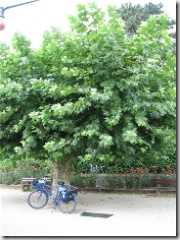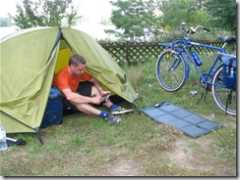Distance since last post: 40km
Weather: Mixed, cloudy. Hazy. Warm 20-22 degrees
Notes: Feeling really good. No aches. Pushing harder today. Cant stop eating sultanas! The hills on each side of the Rhein are getting bigger!
Winter is coming…If you take notice of the geese that is. I saw a flock flying south (following the River perhaps) this morning and wondered if they knew something that I didn’t. Its was lovely and warm yesterday and its pretty much the same today. Is there some nasty weather around the corner or did they get an SMS from some Geese mates in Africa telling them to come early?
Although its been warm its been very cloudy today. Much cloudier than yesterday and yet I still managed to get some charge into the Li-Ion battery and (I think) something into the lead-acid battery. Despite that though I’m using my spare battery and thinking carefully how to use the UMPC more efficiently. Daytime use (like now!) is not the best as the backlight needs to be turned right up. That’s draining an extra 2 watts compared to evening use when I can drop the backlight to minimum.
 I felt very strong this morning and powered the 85KG bike/baggage combo through to Mainz in much less time than I had planned. It was really enjoyable. While the clouds where thick I kept on cycling and ended up in Eltville where the was a lovely Rhein terrace restaurant serving Spargel Suppe (Asparagus Soup.) I stayed for an hour while the solar panel and bike rested by a tree and then layed myself down on a bench for an after-lunch nap. After buying, writing and sending a few postcards I carried on the journey. The Rhein-side path was pretty bumpy and at every chance I tried to find another route but this was really the only sensible offering, the other being a trek up to the hills! Then, after about ten minutes I heard a crash behind me and stopped as quickly as I could. I looked back to see the battery packs and cables strewn across the path along with the shattered container. Shit! I gathered it all together, repacked it and then checked everything out.I think I’ve been lucky. Everything seems to be working still so I think it was just a warning from above to tell me not to take afternoon naps!
I felt very strong this morning and powered the 85KG bike/baggage combo through to Mainz in much less time than I had planned. It was really enjoyable. While the clouds where thick I kept on cycling and ended up in Eltville where the was a lovely Rhein terrace restaurant serving Spargel Suppe (Asparagus Soup.) I stayed for an hour while the solar panel and bike rested by a tree and then layed myself down on a bench for an after-lunch nap. After buying, writing and sending a few postcards I carried on the journey. The Rhein-side path was pretty bumpy and at every chance I tried to find another route but this was really the only sensible offering, the other being a trek up to the hills! Then, after about ten minutes I heard a crash behind me and stopped as quickly as I could. I looked back to see the battery packs and cables strewn across the path along with the shattered container. Shit! I gathered it all together, repacked it and then checked everything out.I think I’ve been lucky. Everything seems to be working still so I think it was just a warning from above to tell me not to take afternoon naps!
Only about 20km to go until the campsite and having looked closely at my plan, it appears that I’m ahead in terms of distance but behind in terms of energy capture. I need to take longer breaks. But no afternoon naps!!




















